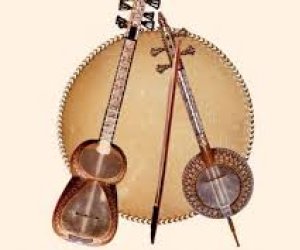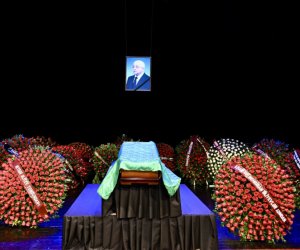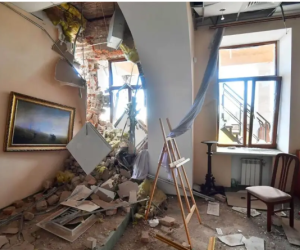Museum of Lost Objects: Looted Sumerian Seal

In April 2003, almost the entire collection of ancient cylinder seals was stolen from the Iraq Museum in Baghdad - and it remains missing.
In the chaotic, violent April of 2003, as US tanks rolled into Baghdad, the Iraq Museum was broken into and pillaged. Looters rampaged through the halls, storerooms, and cellars, stealing more than 15,000 precious objects.
"It was terrible. You didn't want to believe it," says Iraqi archaeologist Lamia al-Gailani, who worked for many years at the museum before moving to London.
"Especially hearing about objects that you know, and then people start saying they've gone - it was a shock."
Back in the 1960s, al-Gailani - one of Iraq's first female archaeologists - spent eight years helping to document the museum's collection of 7,000 cylinder seals.
These seals were an ancient tool for signing documents or sealing important goods, each carved all over with pictures that told a story.
One of Lamia's favourites was found in Hamrin, north of Baghdad. At 4,600 years old it's the oldest object in our Museum of Lost Objects, and at 3.9cm (1.5in) high, also the smallest.
When rolled in wet clay, it vividly depicts an ancient harvest festival, presided over by a powerful goddess, as pictured above.
"The goddess is an agricultural goddess," says al-Gailani. "Her chair is a man with a branch in his hand! It's an attendant and she's sitting on him. You don't see that often. Really this is very unique."
In front of the goddess, the scene is split into two tiers. The upper tier shows a group of men in a boat, travelling by river to the festival. There's also a goat which represents the produce or property of the temple.
The lower tier depicts more figures carrying items on their heads - probably baskets containing agricultural produce - which are then placed in a big pile in front of the goddess.
It's a reminder of the importance of ancient Mesopotamia's relationship to the earth. It was the agricultural revolution in this part of the world that led, eventually, to the birth of human civilisation.
When Baghdad was captured by the Americans on 9 April 2003, the museum was one of many cultural and historical sites that were left unprotected.
It's said a small boy climbed through a window and let everyone in.
The staff tried to chase the looters away. To begin with, they were just interested in practical things - chairs, computers, telephones. But then, as the hours and eventually days went by, they took the artefacts themselves.
The Museum of Lost Objects traces the stories of 10 antiquities or ancient sites that have been destroyed or looted in Iraq and Syria
Listen to the episode about the Sumerian Seal on Radio 4 from 12:00 GMT on Friday 11 March or get the Museum of Lost Objects podcast
Read the complete series: The Winged Bull of Nineveh, The Temple of Bel, The Tell of Qarqur, Aleppo's minaret, The Lion of al-Lat, Mar Elian's monastery, The Unacceptable Poet, The Der Zor memorial and The Genie of Nimrud.
The 4,500-year-old Harp of Ur, one of a collection of finds that comprise the world's oldest stringed instruments, was later found smashed in the car park, stripped of its gold inlay and precious stones.
The priceless Warka Vase - a beautifully carved 5,000-year-old stone vessel - disappeared.
Someone even stole the 150kg Bassetki Statue, a 4,000-year-old copper monument showing the legs of a seated nude figure. Cracks on the staircase and floor suggested its new owners dropped it a few times on their way out the building.
It seems it was only at the insistence of the British Museum in London that soldiers were eventually sent to guard what was left of the collection.
According to John Curtis, who was Keeper of the Middle East Section at the British Museum, his director Neil MacGregor phoned the Prime Minister's office and urged them to contact the White House about saving the Iraq Museum. Tanks arrived outside the building later that day.
A week later, Curtis and McGregor were in Baghdad at the invitation of Donny George, one of the directors of the Iraq Museum, and a close colleague of theirs.
"Nobody had been in since the tanks had arrived," says Curtis.
"We parked in the museum forecourt and actually slept the night there on the colonnade outside the main door. Even when we went there was gunfire to be heard all around.
"It was an appalling sight inside the museum, and a lot of it was just gratuitous violence. Cases have been smashed and broken even when they didn't have anything in them, for no good reason.
"There was clearly a great deal of resentment on the part of the local populace. The museum was a government symbol, and there was a lot of anti-government feeling. So people took it out on all those buildings and institutions which they perceived to be associated with the government."
Lamia al-Gailani says her Arab friends had trouble accepting that Baghdadis may have been responsible for looting their own treasures.
"Everyone had their own theory of who looted the museum," she says. "It depended on who they don't like. Was it the Americans? Was it the Israelis? Was it the Kuwaitis? It was very funny, but also sad that they never, never accused the actual people in Baghdad of looting."
The following month al-Gailani returned to the museum to see things for herself.
"I got out of the taxi and I saw Donny coming down the drive, very excited. He gave me the biggest hug in the world and he whispered into my ears, 'We've just had the Warka Vase back and it's there in the boot of that car!'"
She recalls entering the museum and seeing the staff standing in the lobby, dazed. "They were in such a state of shock that I remember not a single one of them was able to finish a sentence. It was eerie and terrible to see the museum empty like that."
The Iraqi authorities granted a "no-questions-asked" amnesty that allowed people to bring stolen goods back without fear of arrest. In this way, the Warka Vase was returned - and there was even a tip-off about the Bassetki Statue, which was found doused in a cesspool in the suburbs of Baghdad.
But while many items were recovered, 5,000 cylinder seals - including our little harvest seal - remain missing. The seals were kept in the basement storerooms of the museum, described by al-Gailani as "like a labyrinth".
"Every time I went down, I would shout out to the person in front of me so I knew which way to go," she recalls.
"The seals were in a corner, in small boxes put on top of a cabinet. How did the looters find it unless they knew where they are? You can blame anybody. They could be outsiders, but they've heard about them - or it could be people within the museum.
"No-one was caught because of the museum looting. No-one. Not a single person."
But thanks to the dogged work of Iraqi officials, thousands of stolen objects have now been recovered.
In February 2015, the Iraq Museum was officially reopened for the first time since the American invasion.
Al-Gailani went back again, and discovered to her delight that some beloved artefacts had made a return journey from her own personal Museum of Lost Objects.
"I was going round the museum and seeing some of the objects which I thought were looted," she says. "To see them again, it's like seeing friends."
(BBC)
www.ann.az




































 Photo
Photo 



 Video
Video 

